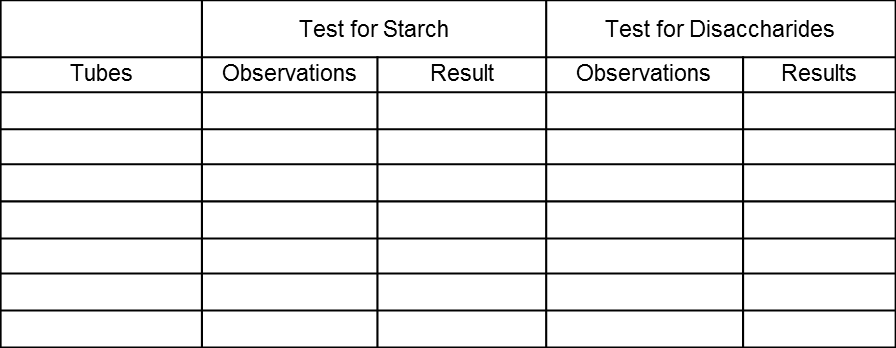Activity – Effect of Amylase on Starch.
This exercise will examine the effects of amylase on starch. Remember amylase is the enzyme found in the mouth produced by the salivary glands (salivary amylase) and also duodenum produced by the pancreas (pancreatic amylase) responsible for the digestion of starch. Starch, a polysaccharide, will be broken down to disaccharides, smaller chains of glucose, such as maltose for example. These smaller chains will then be broken down further by other enzymes, in the case above maltase, to glucose molecules. The cells then use glucose to produce ATP.
1. Collect 7 test tubes and add the following to each tube. Label the tubes. Use graduated cylinders to measure your solutions.
a. Tube 1 ADD 1 ml of amylase + 5 ml of distill water
b. Tube 2 ADD 5 ml of starch solution + 1 ml of distill water
c. Tube 3 ADD 1 ml of amylase solution
d. Tube 4 ADD 1 ml of amylase solution
e. Tube 5 ADD 1 ml of amylase solution
f. Tube 6 ADD 1 ml of amylase solution
2. Incubate the following tubes as indicated.
a. Tube 1 – 3 – incubate at 37 C
b. Tube 4 – leave at room temperature.
c. Tube 5 – incubate on ice.
d. Tube 6 – place in boiling water for 5 minutes. 500 ml beaker or larger, with 300 ml of water on a hotplate.
3. After 5 minutes of incubating tubes 3 – 3 ADD 5 ml of starch to each one. DO NOT REMOVE THE TUBES FROM THE INCUBATING CONDITIONS. TRY TO ADD THE STARCH WHILE THEY ARE INCUBATING IN THE SET CONDITIONS.
4. After adding the starch, continue incubating tubes for 30 mins.
Testing for Starch and Disaccharides
Test for starch using iodine. The iodine molecule binds to starch, if present, and forms a blue-black color. In the absence of starch a light brown color will be seen.
1. After the incubation time is up, place a drop of each of the tubes above, 1 – 7, on a piece of paraffin or on a depression plate.
2. Add one drop of iodine to each one and record any change in color.
Test for simple sugars using Benedict’s solution. When starch is broken down it will result in disaccharides, maltose for example. When these simpler sugars are heated in the presence of Benedict’s solution, a yellow to brick-red color change may occur. In the absence of these simple sugars the color will be unchanged after heating.
1. Add 1 ml from each test tube to be tested (tubes 1 -7) in a clean test tube.
2. Add 1 ml of Benedict’s solution to each one.
3. Incubate in boiling water bath for 3 minutes.
4. Remove the tubes and record the colors.
Complete the table below with your observations (color change) and results (interpretation of your observations). Give the table a title.
Table 1. _________________________________________________________________




